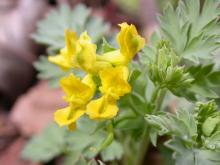Wildflowers, Grasses and Other Nonwoody Plants
Media

Species Types
Scientific Name
Cirsium altissimum
Description
Tall thistle is a native thistle that can grow to be 10 feet tall! To identify it, notice its leaves, which are unlobed (though they may be wavy or have only shallow, broad lobes), are felty-hairy beneath, and have prickles only along the edges.
Media

Species Types
Scientific Name
Cirsium arvense
Description
Canada thistle is a native to Eurasia and arrived on our continent probably before the Revolutionary War — most likely mixed in agricultural seed. A bad weed of crop fields and rangeland farther north, it causes problems in Missouri, too.
Media

Species Types
Scientific Name
Hibiscus lasiocarpos
Description
Hibiscus in Missouri? You bet! Hairy rose mallow is a native perennial whose 6-inch-wide blossoms look a lot like those of its tropical relatives. The stalks can get woody and can grow to 8 feet tall.
Media

Species Types
Scientific Name
Impatiens capensis
Description
Many Missouri children learn about this orange-flowered native plant by playing with the juicy green seedpods, which, when ripe, "explode" upon the slightest touch. This is jewelweed's mechanism for seed dispersal, and it's the reason for the name "touch-me-not."
Media

Species Types
Scientific Name
Ludwigia peploides
Description
Water primrose is a common shoreline plant with bright yellow flowers and long, trailing stems. It grows in dense mats in the shallow areas of ponds, lakes, and streams.
Media

Species Types
Scientific Name
Impatiens pallida
Description
Our two Missouri jewelweeds occur in the same habitats, often side by side, and even botanists can’t tell them apart without the flowers. Pale touch-me-not is the one with the lemon-yellow flowers!
Media

Species Types
Scientific Name
Lythrum salicaria
Description
Anyone who’s seen what purple loosestrife has done to New England and the Northeast can tell you how invasive this plant is. Learn how to identify it, so you can report any findings to the Missouri Department of Conservation.
Media

Species Types
Scientific Name
Trifolium stoloniferum
Description
Running buffalo clover spreads by sending out long, creeping runners. Now endangered, this native perennial once flourished along streams and buffalo trails throughout the grasslands of the eastern and central United States.
Media

Species Types
Scientific Name
Lamium amplexicaule
Description
In early spring, henbit carpets entire fields with the pinkish-purple of its small flowers. This nonnative mint spreads abundantly but causes few problems. It has shallow roots and fades before crops begin to grow.
Media

Species Types
Scientific Name
Corydalis flavula
Description
The smooth, finely divided, fernlike foliage of pale corydalis is similar to that of the related wildflower Dutchman’s breeches. But in pale corydalis, the small yellow flowers appear tubelike and lipped.
See Also
About Wildflowers, Grasses and Other Nonwoody Plants in Missouri
A very simple way of thinking about the green world is to divide the vascular plants into two groups: woody and nonwoody (or herbaceous). But this is an artificial division; many plant families include some species that are woody and some that are not. The diversity of nonwoody vascular plants is staggering! Think of all the ferns, grasses, sedges, lilies, peas, sunflowers, nightshades, milkweeds, mustards, mints, and mallows — weeds and wildflowers — and many more!





















